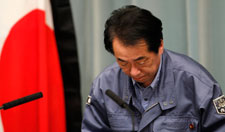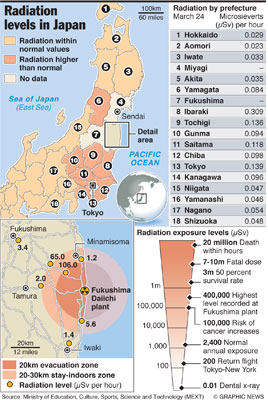TOKYO, March 26 (Reuters) - Japanese engineers were frantically attempting today to pump out puddles of radioactive water at the earthquake-crippled Fukushima nuclear power plant after it injured three workers and delayed efforts to cool reactors to safe levels.
Underscoring growing international qualms about nuclear power raised by the killer earthquake and tsunami in northeast Japan two weeks ago, U.N. Secretary-General Ban Ki-moon said it was time to reassess the international atomic safety regime.
 |
| Prime Minister Naoto Kan bows in front of the Japanese flag with a black mourning cloth during a news conference in Tokyo on Friday. Reuters |
Radioactive water has been found in buildings of three of the six reactors at the power complex 240 km (150 miles) north of Tokyo. On Thursday, three workers sustained burns at reactor No. 3 after being exposed to radiation levels 10,000 times higher than usually found in a reactor.
“Bailing out accumulated water from the turbine housing units before radiation levels rise further is becoming very important,” said Japan Nuclear and Industrial Safety Agency senior official Hidehiko Nishiyama.
The 9.0 magnitude quake and giant waves on March 11 left more than 10,000 people dead and 17,000 missing.
Despite such a shocking toll, much attention since the disaster has been on the possibility of a catastrophic meltdown at Fukushima.
With elevated radiation levels around the plant triggering fears across the nation, storage of the contaminated water has to be handled carefully. “We are working out ways of safely bailing out the water so that it does not get out into the environment, and we are making preparations,” Nishiyama said.
He initially said the high radiation reading meant there could be damage to the reactor, but he later said it could be from venting operations to release pressure or water leakage from pipes or valves.
“There is no data suggesting a crack,” he said.
Nuclear watchdog the International Atomic Energy Agency (IAEA) said on Friday there had not been much change in the crisis over the previous 24 hours.
“Some positive trends are continuing but there remain areas of uncertainty that are of serious concern,” agency official Graham Andrew said in Vienna, adding the high radiation could be coming from steam.
On Friday, Nishiyama chided plant operator Tokyo Electric Power Co (TEPCO) for not following safety procedures inside the turbine building. Local media also criticised TEPCO, which has a poor safety record.
“The people on the spot have a strong sense of mission and may be trying to rush,” the Nikkei business paper said. “But if the work is done hastily, it puts lives at risk and in the end, will delay the repairs. This kind of accident ought to have been avoidable by proceeding with the work cautiously.”More than 700 engineers have been working in shifts to stabilise the plant and work has been advancing to restart water pumps to cool their fuel rods.
Two of the plant's reactors are now seen as safe but the other four are volatile, occasionally emitting steam and smoke.
However, the nuclear safety agency said today that temperature and pressure in all reactors had stabilised.
When TEPCO restored power to the plant late last week, some thought the crisis would soon be over. But two weeks after the earthquake, lingering high levels of radiation from the damaged reactors has kept hampering workers' progress.
At Three Mile Island, the worst nuclear power accident in the United States, workers took just four days to stabilise the reactor, which suffered a partial meltdown. No one was injured and there was no radiation release above the legal limit.
At Chernobyl in the Ukraine, the worst nuclear accident in the world, it took weeks to “stabilize” what remained of the plant and months to clean up radioactive materials and cover the site with a concrete and steel sarcophagus
Radiation spike in sea near Fukushima plant
SENDAI, Japan, March 26, (AFP) - Radiation levels have jumped 10-fold in days in seawater near Japan's tsunami-hit nuclear plant, officials said today, as workers battled to stabilise the crippled power station.
Drinking a half-litre (20-ounce) bottle of similarly contaminated fresh water would expose a person to their annual safe dose, said an official who however ruled out an immediate threat to aquatic life and seafood safety.
The iodine-131 level in the Pacific Ocean waters just off the Fukushima plant was 1,250 times above the legal limit -- compared with readings of 126 times higher taken on Tuesday, and 145 higher on Thursday.
“This is a relatively high level,” nuclear safety agency official Hidehiko Nishiyama said in a televised news conference on the test results from Friday released by plant operator the Tokyo Electric Power Company (TEPCO).
Assessing the likely impact on aquatic life, Nishiyama added: “Generally speaking, radioactive material released into the sea will spread due to tides, so you need much more for seaweed and sea life to absorb it.”He added that because iodine-131 has a half-life -- the time in which half of it decays -- of eight days, “by the time people eat the sea products, its amount is likely to have diminished significantly.” However, TEPCO in a statement also said that levels of caesium-137, which has a half life of about 30 years, was 79.6 times the legal maximum.
The assurances did little to lift the gloom that has hung over Japan since a massive 9.0-magnitude earthquake struck on March 11 and sent a monster tsunami crashing into the northeast coast in the country's worst post-war disaster.
IAEA faces nuke plants challenge
VIENNA (Reuters) - The closing of aging nuclear reactors is
expected to peak in 2020-30, posing a major challenge in terms of safety and the environment, a draft U.N. atomic agency report says.
The report, submitted to member states of the International Atomic Energy Agency (IAEA) shortly before Japan's nuclear crisis erupted this month, said the global nuclear sector maintained a high level of safety performance in 2010.
Work problems from arthritis may come and go
NEW YORK (Reuters Health) - Many people with arthritis have
periodic difficulties on the job, but the problems might not make them less productive, a new study suggests.
And in many cases, simple changes in the workplace can be helpful. |



